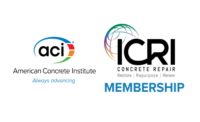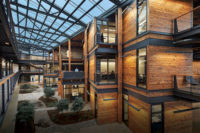Warning Signs to Look for in High-Rise Concrete Structures

It goes without saying that the collapse of the Champlain Towers South in Surfside, Fla. on June 24, 2021 was a complete shock and tragedy. While the cause of the collapse has yet to be determined, the question of safety, building codes, concrete and high-rise structures has been the topic of discussion as of late, and likely will be for some time to come.
It’s important to know the local and up-to-date building codes in the area you’re designing. In addition to state-wide requirements, some counties have their own specific provisions, such as Miami-Dade. These codes exist solely to ensure the safety of the habitants. The codes also include material standards, design loading and durability requirements.
“The first thing that should be considered for the safety of its occupants by architects is the structural stability of the building,” says David G. Karins, P.E., S.I., President & CEO of Karins Engineering in Sarasota, Fla. “For this a qualified and experienced structural engineer is essential. Escape routes, air quality, fire resistance and sanitation are also fundamentally important. To enhance safety, redundant load paths and structural resiliency are also very important.”
Inspection and repair demands are also major things to consider when designing high-rise concrete structures. Some preliminary warning signs include cracks or bulging in the concrete, stains, displacements, leakage, standing water and spalls. Most of the time, these signs show up near balconies or columns, and can happen as early as 2-3 years after the initial build. If any of these symptoms of distress are discovered—design professionals should be immediately contacted.
“Inspection frequency should be considered on an individual basis,” Karins says. “Higher frequency would be advisable for buildings with high exposure to deleterious influences (i.e. salt laden air at beach front condos, frequent vibrations at buildings next to train tracks or heavy industry/construction, etc.). Vulnerability to structural problems should also be considered (metal/reinforced concrete exposure to humid salty conditions, brittle unreinforced buildings and facades exposure to winds/earthquakes/vibrations, etc.). Consequences of failure should also be considered including loss of life, interruption of commerce/transportation, etc.”
Among its many initiatives, International Concrete Repair Institute, Inc. members develop technical guidelines and certification programs and provide educational information to the public regarding all aspects of concrete repair.
“ICRI is committed to advancing the American Concrete Institute 562, Code Requirements for Assessment, Repair, and Rehabilitation of Existing Concrete Structures,” says Elena Kessi, current President of ICRI and President of Aquafin Building Product Systems. “The code was developed to provide design professionals involved in the assessment of concrete structures a code for the evaluation of the damage and deterioration, and the design of appropriate repair and rehabilitation strategies. The code provides minimum requirements for assessment, repair, and rehabilitation of existing structural concrete buildings, members, systems, and where applicable, nonbuilding structures.”
In the coming weeks, ICRI will be launching a series of free on-demand educational content and video presentations to provide general information about common concrete repair practices. For more information, visit their website at www.icri.org.
It’s no surprise that there’s a sudden rise in calls for condo inspections. We'll await the results of the complete investigation into what was really behind this horrible tragedy, and we'll continue to educate our readers on the latest building codes, safety issues and technical details that go into designing structures of all types and sizes.
Looking for a reprint of this article?
From high-res PDFs to custom plaques, order your copy today!







